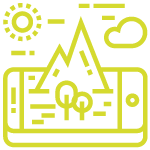How geospatial influences our daily lives
Think about geospatial and you may think of national mapping agencies like Ordnance Survey, of defence satellites or high-end processes deep inside big industry in the present and for the future.
The truth is that geospatial is here and now and improving our lives every day. Here are seven examples of “common or garden” geospatial.
 1.In-car satellite navigation
1.In-car satellite navigation
Today, we take it for granted but in-car sat nav is still a big thing for commercial and private applications and being refined daily. We may curse when it steers us wrong – which is increasingly rare – but overall, the good old sat nav saves us time, money (and domestic strife) every day. According to one survey, sat nav users burned 12% less fuel than drivers without.
These days, they can re-route you around traffic jams and help you avoid speeding fines, too. More money saved. Of course, this is also critical data for any self-driving vehicles as well as any public transport services.
2. Wearable tech
If you’re a jogger, a walker or a cyclist you probably have some tech strapped to your wrist that tells you how well you’re doing. You can record and share routes … and your performance, too.
But, wearable tech’s not just for sports. It’s also being used to keep the elderly safe and independent in their own homes for longer. GPS trackers can warn if someone (with mild dementia, perhaps) has strayed from their expected location, alerting carers and family so that they can intervene promptly.
3. Super selfies
Take a selfie of “that view” from the Accademia Bridge, with the Salute in the background, post it on social media and even the hard-of-geography will know you were in Venice. Use Facebook Check-in at your favourite restaurant – or stuck in the airport – and all your friends can find you.
When you get home after a thrill-filled weekend, the photos on your phone will tell you exactly where you were.
Geotagging is everyday geospatial for all of us.
 4. Augmented and Virtual Reality
4. Augmented and Virtual Reality
For some, Pokémon Go is the ultimate in augmented reality. It may not still enjoy the hype it attracted for its 2016 launch, but the AR gaming pioneer saw a 35% growth in 2018 and recently announced the release of new creatures, including Turtwig, Chimchar and the adorable Piplup (no, really).
It’s not just Pokémon Go. Other activities like geocaching also have geospatial at their heart.
5. Social Media location services
They say that one in four relationships now starts online.
When your favourite dating app finds 15 (potential) soul-mates in the near vicinity, that’s geospatial in action. There’s no guarantee of their personal qualities, but their proximity should be sound. Especially as online dating is increasingly in your pocket, rather than the corner of your bedroom (or office).
Like so many other location-based activities, the smartphone has made dating super-local.
6. Tracking
Tracking, too, has become everyday. Logistics firms track containers and trucks; utility firms use geospatial data to locate and monitor assets buried underground; and insurance companies can track insured vehicles (or other assets).
As an individual, you can find your lost phone, or your lost pet. Matching micro-chipped pets with online records makes it easier to track lost owners.
In our Little Book of Smart Cities, we gave the example of the Australian county of Moorabool, Victoria, where council rangers can view pet registrations on their GIS system and search by breed or colour to reunite owners and pets.
7. Smart Cities getting smarter
Geospatial data is making our built environment smarter in all sorts of ways. Not only can you find your doggy, you can find a parking space, too. Stressed drivers might say this is the ultimate use of location data. Some solutions simply direct you to the nearest public carpark, others let micro-entrepreneurs rent out their empty drives. A more advanced, smart cities approach uses sensors to identify free parking spaces and guide the user straight to his or her slot.
Of course, solving your parking problems is just one everyday example of how our cities are getting smarter. Increasingly, every aspect of our built environment is getting smarter … and more effective: public transport, energy use, flood risk monitoring, crime-fighting, education and welfare all benefit from the addition of location data. If you’d like to learn more, check out our recent Little Book of Smart Cities.
Not so special geospatial
Geospatial, the technology, the data, the real-time analysis is all around us. It’s improving our lives in ways we don’t even notice, and easily taken for granted.
As our in-pocket (and on-wrist) technology gets ever more powerful, the opportunities for geospatial to add value to our lives get even greater.

